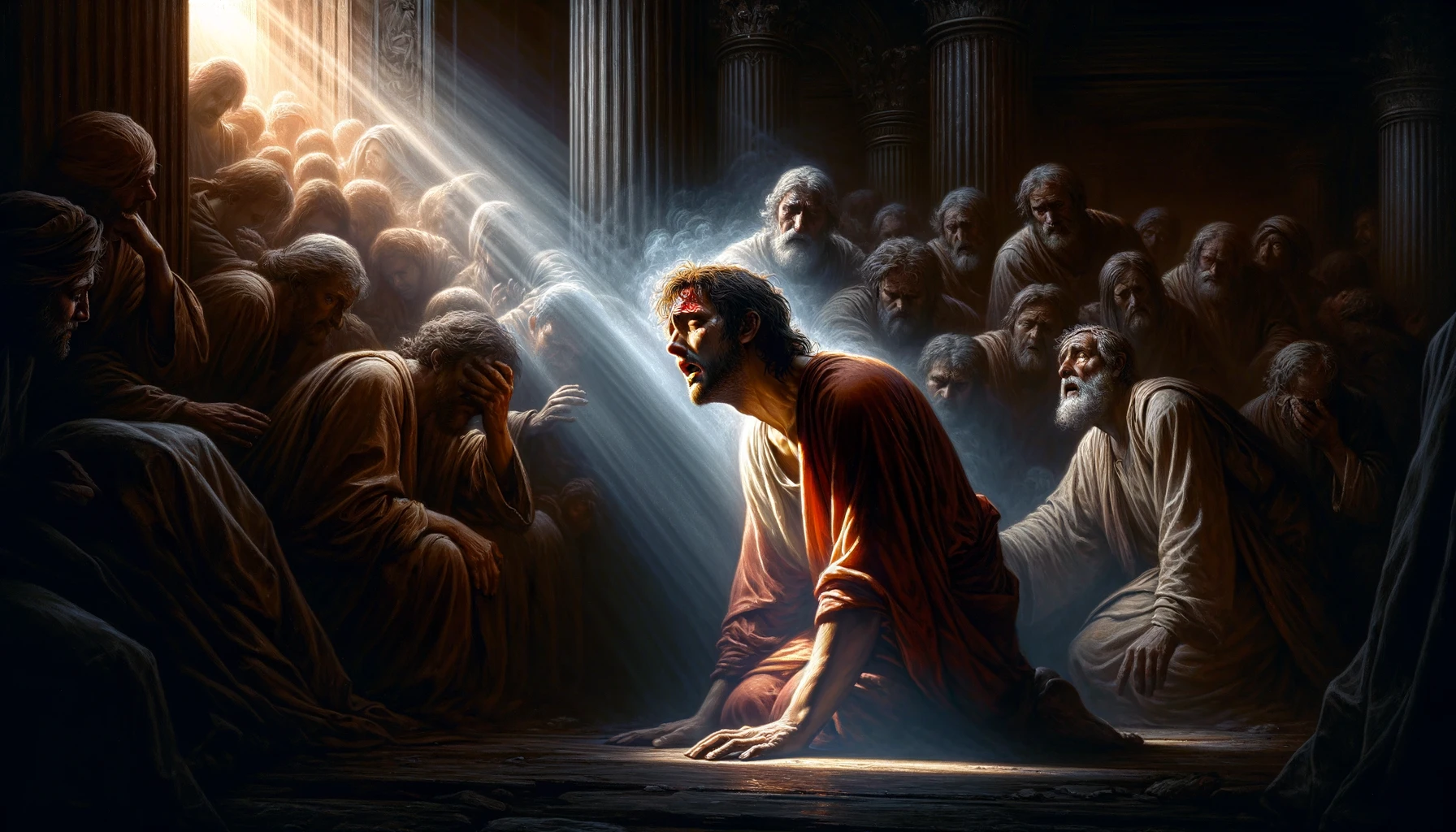Home>Special Themes>What Does The Bible Say About Advent


Special Themes
What Does The Bible Say About Advent
Published: February 12, 2024
Jason DeRose, Managing Editor at Christian.net, uses his expertise in religion and journalism to deepen understanding of faith's societal impacts. His editorial leadership, coupled with a strong academic background, enriches the platform’s diverse content, earning him recognition in both journalism and religious circles.
Discover what the Bible says about Advent and its special themes. Explore the significance of this season in Christian faith and practice.
(Many of the links in this article redirect to a specific reviewed product. Your purchase of these products through affiliate links helps to generate commission for Christian.net, at no extra cost. Learn more)
Table of Contents
Introduction
Advent is a significant period in the Christian calendar, marking the beginning of the liturgical year and the anticipation of the birth of Jesus Christ. This sacred season, observed by many denominations, holds deep spiritual meaning and is characterized by a sense of hope, preparation, and joyful expectation. As we delve into the biblical perspective on Advent, it's essential to understand the historical, cultural, and religious significance that underpins this revered tradition.
The word "Advent" originates from the Latin word "adventus," which translates to "coming" or "arrival." It symbolizes the awaiting of the Messiah's arrival and the preparation for the celebration of Christ's birth. This period typically begins on the fourth Sunday before Christmas and spans the four weeks leading up to the joyous occasion of Jesus' nativity.
During Advent, Christians reflect on the prophecies foretelling the coming of the Savior, emphasizing the themes of hope, love, joy, and peace. It serves as a time of spiritual introspection, where believers are encouraged to prepare their hearts and minds for the commemoration of the incarnation of Jesus, the central figure of the Christian faith.
As we embark on this exploration of Advent in the Bible, we will uncover the rich symbolism, historical context, and scriptural references that illuminate the profound significance of this season. Through a deeper understanding of Advent, we can gain insight into the foundational principles of the Christian faith and the enduring message of hope and redemption that resonates throughout the ages.
Read more: What Does The Bible Say About Catholicism
The Meaning of Advent in the Bible
Advent, as depicted in the Bible, encapsulates the profound anticipation of the Messiah's arrival and the spiritual preparation for the fulfillment of God's promise. Rooted in the Old Testament prophecies, the concept of Advent is intricately woven into the fabric of biblical narratives, serving as a testament to the divine plan of redemption and salvation.
The essence of Advent is intricately intertwined with the prophetic utterances found in the scriptures, particularly in the books of Isaiah, Micah, and Jeremiah. These prophetic voices herald the coming of a savior, foretelling the birth of a child who would bring light to a world shrouded in darkness. The anticipation of this promised deliverer permeates the pages of the Old Testament, instilling a sense of hope and expectation among the people of Israel.
In Isaiah 7:14, the prophet Isaiah prophesies, "Therefore the Lord himself will give you a sign: The virgin will conceive and give birth to a son, and will call him Immanuel." This prophecy, often cited during the Advent season, foreshadows the miraculous birth of Jesus Christ and underscores the divine orchestration of the Messiah's coming.
Furthermore, the book of Micah, specifically in Micah 5:2, proclaims, "But you, Bethlehem Ephrathah, though you are small among the clans of Judah, out of you will come for me one who will be ruler over Israel, whose origins are from of old, from ancient times." This prophecy not only identifies the birthplace of the Messiah but also emphasizes the eternal nature of the awaited ruler, reinforcing the significance of his advent in fulfilling God's redemptive plan.
The biblical narrative of Advent extends beyond the anticipation of Christ's birth to encompass the overarching theme of God's faithfulness and the fulfillment of His covenant with humanity. It serves as a poignant reminder of God's unwavering promise to send a redeemer, embodying the essence of hope and renewal for all who await his arrival.
In essence, the meaning of Advent in the Bible transcends mere historical anticipation; it embodies the culmination of divine promises, the fulfillment of prophetic declarations, and the dawning of a new era marked by the arrival of the long-awaited Messiah. This profound significance underscores the foundational principles of the Christian faith and illuminates the enduring message of hope, love, and redemption that permeates the Advent season.
The History of Advent
The history of Advent traces its origins to the early centuries of Christianity, evolving from a period of fasting and preparation into a season of profound spiritual significance. The early Christian church, seeking to establish a time of devotion and reflection leading up to the celebration of Christ's birth, laid the foundation for what would later become the Advent season.
The exact emergence of Advent as a distinct liturgical observance is attributed to the 4th and 5th centuries, with the practices varying among different Christian communities. Initially, Advent was characterized by a period of fasting, akin to the Lenten season, as believers engaged in self-examination and repentance in anticipation of the nativity of Christ. Over time, the focus of Advent shifted to encompass a broader sense of spiritual preparation, incorporating themes of hope, joy, and expectation.
The Council of Tours in 567 AD is credited with formalizing the observance of Advent, designating the period leading up to Christmas as a time of spiritual reflection and anticipation. This marked the beginning of the liturgical calendar year, signifying the commencement of a new cycle of worship and devotion for Christians worldwide.
Throughout the medieval period, the observance of Advent continued to evolve, with an increased emphasis on the themes of prophecy, preparation, and the imminent coming of Christ. The symbolism of light gradually became intertwined with the Advent season, symbolizing the arrival of the divine light in the form of the newborn Savior.
The rich historical tapestry of Advent also reflects the interplay of cultural influences, as various traditions and customs became integrated into the observance of this sacred season. From the lighting of Advent candles to the use of the Advent wreath, these customs served to deepen the spiritual significance of the season and foster a sense of communal anticipation and unity among believers.
In contemporary times, the observance of Advent has transcended denominational boundaries, resonating with Christians of diverse traditions and backgrounds. It remains a cherished period of spiritual preparation, inviting believers to engage in prayer, reflection, and acts of kindness as they await the celebration of Christ's birth.
The history of Advent stands as a testament to the enduring legacy of this sacred season, reflecting the timeless themes of hope, anticipation, and the fulfillment of God's promise. As we delve into the historical roots of Advent, we gain a deeper appreciation for the profound spiritual journey that has shaped this cherished tradition, uniting believers across generations in joyful expectation of the coming of the Messiah.
The Importance of Advent in Christian Tradition
The significance of Advent in Christian tradition extends far beyond a mere countdown to the celebration of Christ's birth. It serves as a poignant reminder of the foundational tenets of the Christian faith, encapsulating themes of hope, anticipation, and spiritual preparation. This sacred season holds profound importance for believers, fostering a sense of unity, reflection, and joyful expectation within the Christian community.
Advent embodies the essence of anticipation, mirroring the longing of the ancient Israelites for the promised Messiah. It invites believers to embark on a spiritual journey of introspection and preparation, cultivating a sense of expectancy for the fulfillment of God's redemptive plan. Through the observance of Advent, Christians are encouraged to reflect on the profound implications of Christ's incarnation and the enduring message of hope and salvation that it embodies.
Furthermore, Advent serves as a time of spiritual renewal and reawakening, prompting believers to realign their hearts and minds with the transformative message of the gospel. It offers an opportunity for individuals and congregations to engage in acts of compassion, generosity, and service, reflecting the selfless love exemplified by Christ's birth. This emphasis on spiritual introspection and altruism underscores the enduring relevance of Advent in nurturing a spirit of unity and goodwill within the Christian community.
Moreover, the observance of Advent fosters a sense of continuity and tradition within the Christian faith, connecting believers across generations through a shared experience of joyful anticipation. It provides a sacred space for families, congregations, and communities to come together in prayer, worship, and fellowship, strengthening the bonds of faith and fostering a collective sense of hope and expectancy.
The symbolism and rituals associated with Advent, such as the lighting of the Advent wreath and the progressive unfolding of the nativity narrative, serve to deepen the spiritual significance of the season, imparting a sense of reverence and awe for the miraculous events surrounding Christ's birth. These traditions not only enrich the worship experience but also serve as a tangible expression of the enduring legacy of the Christian faith, reinforcing the timeless message of God's unfailing love and faithfulness.
In essence, the importance of Advent in Christian tradition lies in its ability to encapsulate the core principles of the Christian faith—hope, love, joy, and peace—while fostering a sense of communal anticipation and spiritual preparation. It stands as a testament to the enduring legacy of the gospel message, inviting believers to embrace the transformative power of Christ's birth and to embody its timeless truths in their daily lives.
The Symbols and Traditions of Advent
The symbols and traditions associated with Advent are deeply rooted in rich historical and spiritual significance, serving as poignant reminders of the profound themes of hope, anticipation, and spiritual preparation that define this sacred season. These symbols and traditions not only enrich the observance of Advent but also provide a tangible expression of the enduring legacy of the Christian faith, fostering a sense of unity and reverence within the Christian community.
Read more: What Does The Bible Say About Atonement
The Advent Wreath
One of the most iconic symbols of Advent is the Advent wreath, typically adorned with evergreen foliage and four candles, often accompanied by a central white candle. Each candle represents a different aspect of the spiritual journey leading up to Christmas, with the progressive lighting of the candles symbolizing the increasing anticipation of Christ's birth. The first candle, often purple or blue, signifies hope; the second, also purple or blue, represents love; the third, pink or rose, symbolizes joy; and the fourth, again purple or blue, embodies peace. The central white candle, known as the Christ candle, is lit on Christmas Eve or Christmas Day, signifying the arrival of the light of the world.
The Advent Calendar
The Advent calendar, a beloved tradition in many households, traces its origins to 19th-century Germany and has since become a cherished symbol of the countdown to Christmas. Advent calendars often feature 24 doors or compartments, each concealing a small treat or religious symbol. This tradition serves as a delightful way to engage children and families in the anticipation of Christ's birth, fostering a sense of excitement and wonder as each day brings them closer to the joyous celebration.
The Colors of Advent
The colors associated with Advent—purple, blue, and pink—hold symbolic significance, reflecting the themes of penitence, royalty, and rejoicing. Purple, a color traditionally associated with penitential seasons, underscores the solemnity and introspective nature of Advent, prompting believers to engage in self-examination and spiritual preparation. Blue, a color symbolizing hope and anticipation, serves as a poignant reminder of the imminent arrival of the Messiah, infusing the season with a sense of joyful expectation. The use of pink, often seen on the third Advent candle, represents rejoicing and underscores the theme of joy as the anticipation of Christ's birth intensifies.
The Jesse Tree
The Jesse Tree, a cherished Advent tradition, traces its origins to the Old Testament and serves as a visual representation of the genealogy of Jesus Christ. This symbolic tree is adorned with ornaments, each depicting a significant biblical event or figure leading up to the birth of Christ. The Jesse Tree tradition provides a meaningful way for families and congregations to journey through the Old Testament narratives, tracing the lineage of Jesus and reflecting on the profound significance of his advent in the context of God's redemptive plan.
In essence, the symbols and traditions of Advent serve as tangible expressions of the enduring themes of hope, love, joy, and peace that define this sacred season. They enrich the spiritual journey leading up to Christmas, fostering a sense of unity, reverence, and joyful anticipation within the Christian community, while imparting a deeper understanding of the profound significance of Christ's birth.
The Biblical References to Advent
The concept of Advent, as understood in contemporary Christian tradition, finds its roots in the rich tapestry of biblical narratives and prophetic utterances that foretold the coming of the Messiah. The Old Testament scriptures, particularly in the books of Isaiah, Micah, and Jeremiah, serve as profound sources of biblical references to the anticipation of Christ's advent.
In Isaiah 7:14, the prophet Isaiah delivers a pivotal prophecy, proclaiming, "Therefore the Lord himself will give you a sign: The virgin will conceive and give birth to a son, and will call him Immanuel." This prophetic declaration, often cited during the Advent season, foreshadows the miraculous birth of Jesus Christ and underscores the divine orchestration of the Messiah's coming. The fulfillment of this prophecy in the New Testament, as recorded in the Gospel of Matthew, establishes a direct link between Isaiah's prophecy and the birth of Jesus, affirming the profound significance of his advent in fulfilling God's redemptive plan.
Similarly, the book of Micah, in Micah 5:2, provides another compelling biblical reference to the anticipation of the Messiah's arrival. The prophecy states, "But you, Bethlehem Ephrathah, though you are small among the clans of Judah, out of you will come for me one who will be ruler over Israel, whose origins are from of old, from ancient times." This prophetic utterance not only identifies the birthplace of the Messiah but also emphasizes the eternal nature of the awaited ruler, reinforcing the significance of his advent in fulfilling God's redemptive plan.
Furthermore, the book of Jeremiah, in Jeremiah 23:5, offers a poignant depiction of the anticipated advent of the Messiah, declaring, "The days are coming, declares the Lord, when I will raise up for David a righteous Branch, a King who will reign wisely and do what is just and right in the land." This prophetic proclamation encapsulates the profound anticipation of a righteous and just ruler, heralding the advent of the long-awaited Messiah who would bring forth a new era of divine governance and redemption.
The biblical references to Advent, as encapsulated in these prophetic utterances, serve as poignant reminders of the enduring promise of God's redemptive plan and the anticipation of the Messiah's arrival. These scriptures not only lay the foundation for the observance of Advent but also underscore the profound significance of Christ's birth in fulfilling the divine promises articulated in the Old Testament. As believers reflect on these biblical references during the Advent season, they are invited to embrace the enduring message of hope, love, and redemption that permeates the scriptures, reaffirming the timeless significance of Christ's advent in the Christian faith.
The Significance of Advent in the Christian Faith
The significance of Advent in the Christian faith extends far beyond the anticipation of Christmas; it embodies the foundational principles of the gospel message and serves as a poignant reminder of the transformative power of Christ's birth. This sacred season holds profound importance for believers, fostering a sense of unity, reflection, and joyful expectation within the Christian community.
Advent encapsulates the essence of anticipation, mirroring the longing of the ancient Israelites for the promised Messiah. It invites believers to embark on a spiritual journey of introspection and preparation, cultivating a sense of expectancy for the fulfillment of God's redemptive plan. Through the observance of Advent, Christians are encouraged to reflect on the profound implications of Christ's incarnation and the enduring message of hope and salvation that it embodies.
Furthermore, Advent serves as a time of spiritual renewal and reawakening, prompting believers to realign their hearts and minds with the transformative message of the gospel. It offers an opportunity for individuals and congregations to engage in acts of compassion, generosity, and service, reflecting the selfless love exemplified by Christ's birth. This emphasis on spiritual introspection and altruism underscores the enduring relevance of Advent in nurturing a spirit of unity and goodwill within the Christian community.
Moreover, the observance of Advent fosters a sense of continuity and tradition within the Christian faith, connecting believers across generations through a shared experience of joyful anticipation. It provides a sacred space for families, congregations, and communities to come together in prayer, worship, and fellowship, strengthening the bonds of faith and fostering a collective sense of hope and expectancy.
In essence, the significance of Advent in the Christian faith lies in its ability to encapsulate the core principles of the Christian faith—hope, love, joy, and peace—while fostering a sense of communal anticipation and spiritual preparation. It stands as a testament to the enduring legacy of the gospel message, inviting believers to embrace the transformative power of Christ's birth and to embody its timeless truths in their daily lives.
Conclusion
In conclusion, the exploration of Advent in the Bible reveals a tapestry of profound significance, historical depth, and enduring spiritual relevance. From its roots in the prophetic utterances of the Old Testament to its evolution as a cherished liturgical season in Christian tradition, Advent embodies the timeless themes of hope, anticipation, and joyful expectation.
The biblical references to Advent, as articulated in the prophetic declarations of Isaiah, Micah, and Jeremiah, serve as poignant reminders of the enduring promise of God's redemptive plan and the anticipation of the Messiah's arrival. These scriptures not only lay the foundation for the observance of Advent but also underscore the profound significance of Christ's birth in fulfilling the divine promises articulated in the Old Testament.
The symbols and traditions associated with Advent, including the Advent wreath, calendar, and the use of symbolic colors, enrich the spiritual journey leading up to Christmas, fostering a sense of unity, reverence, and joyful anticipation within the Christian community. These timeless traditions serve as tangible expressions of the enduring themes of hope, love, joy, and peace that define this sacred season, inviting believers to embrace the transformative power of Christ's birth.
The observance of Advent holds profound importance in the Christian faith, serving as a time of spiritual renewal, reawakening, and communal anticipation. It provides a sacred space for families, congregations, and communities to come together in prayer, worship, and fellowship, strengthening the bonds of faith and fostering a collective sense of hope and expectancy.
As we reflect on the historical, cultural, and spiritual dimensions of Advent, we are reminded of the enduring message of hope, love, and redemption that permeates this sacred season. Advent stands as a testament to the enduring legacy of the gospel message, inviting believers to embrace the transformative power of Christ's birth and to embody its timeless truths in their daily lives.
In essence, the exploration of Advent in the Bible illuminates the profound significance of this sacred season, inviting believers to embark on a spiritual journey of introspection, preparation, and joyful anticipation as they await the celebration of Christ's birth.













